|
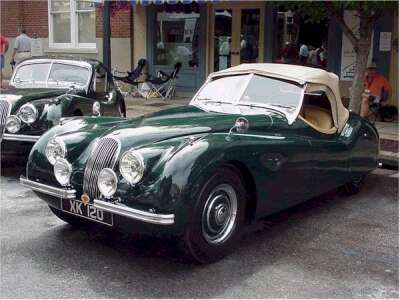 1950 XK120 Roadster. Frank
Rubino (South Florida Jaguar Club)
1950 XK120 Roadster. Frank
Rubino (South Florida Jaguar Club)
Click for more pictures : Previous
- Next |
Only five... Throughout Jaguar 75 year history, only
five models of sports car have graced the company's showrooms and prowled
roads around the world. That's not many and shows that Jaguar usually
gets it right the first time with models that remain in production for
long periods of time, needing only minor updates along the way... The
Jaguar XK sports car is number two in this exclusive lineage and while
its successor, the E-type, may be better known and more recognizable,
the XK120 was as much a revolution when it was launched in 1948 offering
performance and value no other manufacturer could match.
Immediately following World War Two, most of the offerings were still
based on pre war designs; reconstruction and rationing in Britain meant
that it took a few years for new designs to arrive on the market. Rationing
was such that to get raw materials, especially steel, manufacturers had
to export the bulk of their production, helping bringing in currencies
in to the country.
William Lyons, Jaguar's founder, was keen to continue developing the
company he had established some 20 years earlier and he quickly realized
that it meant building his own engines instead of relying on an outside
manufacturer like SS Jaguar had done until this point. With Bill Heynes
leading a small team of engineers, including Wally Hassan and Harry Weslake,
planning and development for Jaguar's new powerplant begun even before
hostilities ended. Over some 3 or 4 years, a number of experimental engines
were designed and tested starting with 4 cylinder models, code named X
for experimental and followed by a sequence letter: XA, XB, etc... Each
gaining a little more power toward the ultimate goal of 160 hp established
by Lyons. In 1948, the current evolution was the XJ engine, a 4 cylinder,
2 liter, dual overhead cam, which developed a little under 150 hp. Interestingly,
it was tested on the same stretch of highway in Jabbeke Belgium where
a few months later, the XK120 would rewrite the record books for production
cars. Installed in a special streamlined lightweight MG, the 4 cylinder
engine pushed the purpose built car to a top speed of 175 mph but when
installed and driven in a Mark V, Lyons felt it lacked the low end torque
needed for the new Jaguar saloon. Back to the drawing board for a 6 cylinder,
3.4 liter version, named XK: Jaguar had the engine it needed to leap over
its competition.
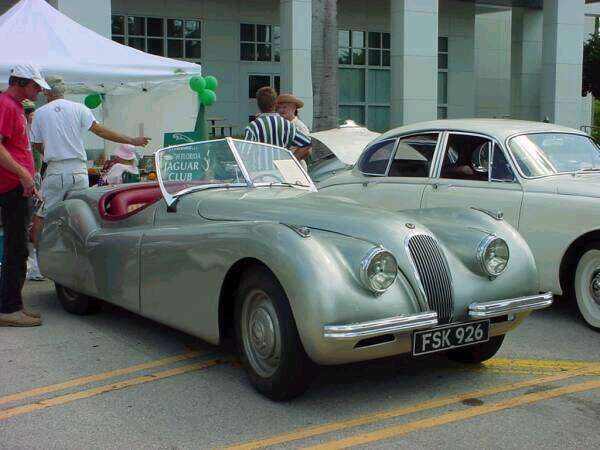 A rare 1949 XK120 alloy body roadster.
Tony Hldebrand (South Florida Jaguar Club)
A rare 1949 XK120 alloy body roadster.
Tony Hldebrand (South Florida Jaguar Club) |
While the engine was ready, the chassis and body of the new saloon were
not and with only two months before the 1948 London Motor Show, Lyons
decided to launch his revolutionary engine in a limited production sports
car. Using a shortened Mark V chassis, a roadster design was drawn and
quickly built to be presented on the Jaguar display at Earls Court. Named
XK120 Super Sport, after the engine and its estimated top speed, the new
Jaguar took the motoring world by storm with its advanced dual overhead
cam engine, elegant lines and promised performance. Full instrumentation
and Connoly leather interior completed the package and yet, just like
many SS Jaguars in the pre war years, the XK120 was offered at a price
that was almost too good to be true: £ 998. There were very few
cars capable of topping at 120mph in 1948 and they were much more expensive;
about 4 times more for a Bugatti 57SC or twice as much for the 3 liter
Alfa Romeo. With a price of just below £ 1000, Jaguar was also taking
advantage of British tax laws which taxed cars priced under £1000
at a much lower rate than those sold for over that amount. Note that for
a while, an even more economical XK100 version was planned, using the
previous generation 2 liter 4 cylinder development XJ engine, but dismissed
at the last minute.
Following the success of the initial launch, a group of engineers was
sent to Jabbeke where the stock XK120 reached an incredible speed of 126mph,
becoming the fastest production car in the world. With the windshield
replaced by a small windscreen, using a tonneau cover and under body tray,
the XK120 topped a jaw dropping 132mph. The group of journalists who was
taken along to Belgium duly noted the performance...
Original plans called for only 200 cars to be built but with orders coming
in, it became clear that the labor intensive aluminum body construction
would have to be replaced by a steel body with pressed panels. Tooling
up took over a year with only a small number of alloy body cars making
it into the showrooms and into the hands of some very lucky owners. By
May of 1950, the production of steel body XK120 began with a large percentage
being exported, mostly to the United States where the 120 became the choice
car of stars and serious drivers. Altogether, a little over 200 aluminum
bodied roadsters were built and needless to say, they are now the most
valuable and sought after of all XK120s.
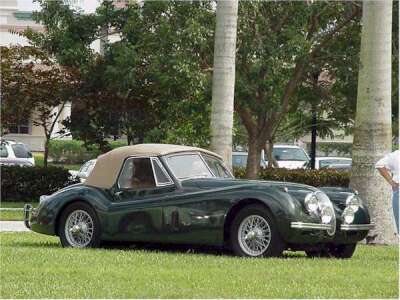 1954 XK120M DHC. Roger Seitz (South Florida
Jaguar Club)
Click for more pictures of
this car: Previous - Next
1954 XK120M DHC. Roger Seitz (South Florida
Jaguar Club)
Click for more pictures of
this car: Previous - Next
|
Demand for the XK120 was also boosted by its success on race tracks in
production sports car races prompting Jaguar to send 3 mostly production
XK120 to Le Mans in the spring of 1950 to see how the cars would fare
against the more established competition. While luck was not on the side
of the team, Jaguar learned some valuable lessons leading to the development
of the XK120C, ultimately known as the C-Type which clinched Jaguar's
first victory at Le Mans in 1951. On the rally scene, Ian and Pat Appleyard
(Lyon's daughter) replaced their trusty and winning SS100 with an XK120
and dominated many of the early 50s events including the difficult and
prestigious Alpine Rally. But as if a 24 hours race was not enough, Jaguar
tested the 120 at Monthlery, a race track outside Paris, for a full 7
days during which the car averaged just over 100mph.
In 1951, after production of the steel bodies was well established, Jaguar
introduced a Fixed Head Coupe which featured rolling up windows instead
of the side screens as well as rear quarter light windows. Its profile
was reminiscent of the SS100 FHC prototype, designed just before the war
but which never made it into production. Minor changes to the rear section
of the car were needed to accommodate the steel roof along with modifications
to the front wings and to the doors. Two years later, in 1953, a Drop
Head Coupe was introduced featuring the more luxurious interior appointments
of the FHC (walnut veneered dash and trim, winding windows) with a heavier,
better sealing and more convenient top incorporating a more complicated
frame, padding and headliner.
For those demanding even more performance, the 120 was available in an
XK120SE version (XK120M in the US) with high lift cams engine producing
180hp (.375" lift versus the .312" lift of the standard cams),
lightened flywheel, stiffer torsion bars & rear springs, dual (heavenly
sounding) exhaust system. Wire wheel were fitted on the SE/M models with
the rear wheel spats removed to provide clearance for the spinner. Later
on, a C-type head with larger 2" SU carburetors could also be ordered,
raising horsepower to 210hp.
In 1954, Jaguar introduced the XK140 (as a 1955 model) which despite
looking almost identical to the XK120, incorporated a number of changes.
On the outside, larger and more protective bumpers were the most prominent
change, along with minor modification to the grille now cast in one piece.
In the engine bay, the engine was moved forward by about 3" allowing
the passenger compartment to be slightly larger giving more leg room and
a better driving position. Steering became rack and pinion instead of
the recirculating ball steering box and the lever arm dampers were replaced
by telescopic dampers. The standard engine was still the 3.4 These changes
were applied to the OTS, DHC and FHC which also gained a small rear seat
thanks to the battery being relocated inside the front wings behind the
wheels. Overdrive was offered as an option and i 1956 a three speed automatic
transmission became availablel. As with the XK120, the XK140SE (or XK140MC
in the US) offered upgraded performance with a C-type head (210hp), wire
wheels, foglights, twin tailpipe exhaust.
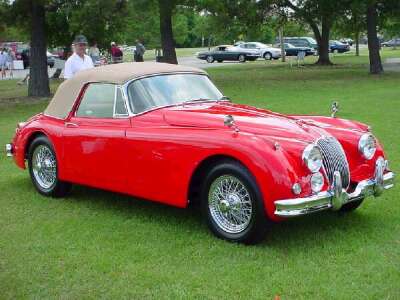
End of an era: 1960 XK 150 DHC. Ronald
Gaertner (Virginia Jaguar Club)
Click for more pictures of
this car: Previous - Next
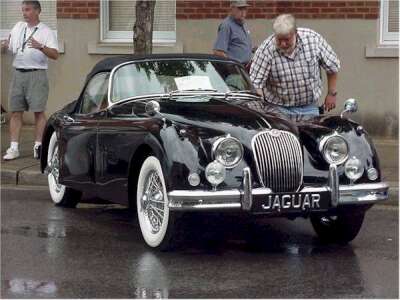
1960 XK 150-S, Terry Wall (Jaguar Society of South Carolina)
Click for pictures of other XKs: Previous
- Next
|
By 1957, almost 10 years after the initial launch of the XK120, Jaguar
unveiled the XK150 which was significantly different from its predecessors.
The lines of the car were straightened out and the windshield was now
a curved single piece. Mechanically, the most important change was the
introduction of disk brakes which Jaguar had pioneered at Le Mans since
1954. The engine remained the same 3.4 liter unit developing 190hp in
base trim and 220hp in SE trim with twin SUs. Originally available as
a FHC and DHC only, a roadster model was offered a year later in 1958.
With the XK150, Jaguar introduced an S model with triple SU carburetors
producing 250hp. By 1958 an even more powerful version was offered with
an optional 3.8 liter engine bringing the horsepower to 265 in S trim.
This would be the same engine and triple SU configuration which would
be used in the E-type in 1961..
The XK150 would remain in production until 1961, although very few were
build in this final year with the E-type being introduced at the Geneva
Motor Show in March. During the 13 years it remained in production, a
total of just over 30000 XKs left Coventry including about 12000 XK120s,
9000 XK140s and 9000 XK150s. Most of the production was exported, with
the United States being the largest market.
But the legacy of the XK extends far beyond the production numbers: it
put Jaguar on the map as a serious sports car manufacturer. The car's
brilliant performance on European, and most importantly on American race
tracks, lied the foundation for Jaguar racing heritage which culminated
with the development of the C-type and D-type and their incredible five
victories at Le Mans in only 7 years. "Race on Sunday, sell on Monday"
was pioneered by Jaguar with the cars carrying a badge on the boot listing
the years of Jaguar's Le Mans victories...
Buying an XK...
The XK is without a doubt the true classic Jaguar sports car because
of its early roots and also because it was the first Jaguar powered by
the legendary XK engine. After the XK150, it would go on powering the
E-type and ultimately the XJ saloon until 1986: an astonishing 38 years
career... Despite what it represents, buying an XK isn't as out of reach
as one may think although prices vary greatly depending on model and body
style.
The rarest and most valuable model, is without a doubt the early XK120
aluminum bodied roadster with only 200 or so built. Also near the top
of the value guides, are the XK150S in part because of their superior
performance but also because of the low production numbers;some top Concours
restorations can exceed $100 000.... Coupes, like with most Jaguar sports
cars, are the most affordable and represent an excellent value for the
money starting as low as $25000 for a decent XK120 or 140 driver. Roadsters
will typically start at around $35000 for a driver, with Concours restoration
reaching up to twice as much. Drop Head Coupes, despite being more expensive
to restore than the roadsters while still offering open air motoring are
normally closer to the coupe's value... M/SE models usually fetch around
$ 5000 over the cost of the base 120 and 140 models along with 3.8 liter
engines in XK150.
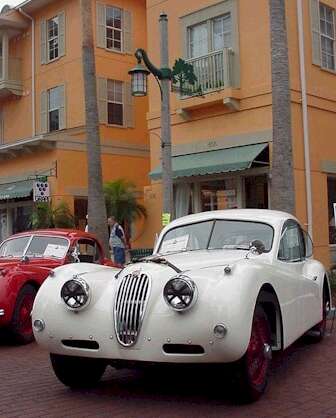 XK140M FHC (Russell Glace, South Florida
Jaguar Club)
XK140M FHC (Russell Glace, South Florida
Jaguar Club) |
Rust is definitely the main concern when considering an XK, although
the traditional body on frame construction means the condition of the
body is less critical than on a monocoque model like the E-type where
many body panels are structural. Nevertheless, the body is a complicated
structure which can be expensive to repair.
Mechanically, despite its performance the XK is fairly simple and the
engine is as bullet proof as they get. The Moss box is equally strong
and just like the engine benefits from having been in production for so
many years. With so many of these cars still on the road (or Concours
fields), parts are still easy to get with a number of specialized suppliers
right here in the US.
As with any classic Jaguar, it is really critical to have the car inspected
by someone familiar with them before making a decision. A specialist will
know where to look for and will also be able to quickly evaluate the condition
of the engine.
Matching numbers and low mileage are nice but the overall condition is
really what will influence its price the most. Originality is important
as well; even if you don't plan on entering the car in Concours competition,
a future owner may want to; while some items can easily be reverted to
original, others may not. For instance, a non Jaguar paint color will
affect the car's value because of the high deductions it will receive
at a Concours and the high cost to repaint the car.
Driving an XK...
There is something very classic about an XK being driven on the road.
It has those post war lines, long fenders and bonnet but despite its character,
it is also a very capable performer with plenty of power and good handling.
In case of the XK150, or earlier upgraded cars, the disc brakes bring
in extra safety and help make the XK an excellent road car. Many XK owners
drive their cars on a regular basis, on club outings, rallies and even
cross country tours; unlike most lesser cars built in the post war era,
the XK can hold its own on the road with modern cars...
The XK120 is obviously the original and as such it is often seen as the
purest of the XKs which comes at a slight price with less room than the
140 or 150 and a slightly less comfortable position. The extra 3"
gained by moving the engine forward on the XK140 make a big difference
in driver comfort. Roadsters have these pure lines but when driven in
less than perfect weather, the protection and comfort of the FHC or DHC
is a big big plus although the coupes will be hot in summertime...
What they all share is the same glorious roar when the XK engine is fired
up, filling your ears with a very special exhaust note while on the road.
Follow an XK on the road for a few miles and you will understand! Acceleration
is brisk, but gear changes may take a while getting used to. The 4 speed
Moss box (used all the way until the first few years of the E-type) isn't
exactly as easy to shift as a modern box with its non synchro'ed fist
gear. However, its low speed whine adds a certain charm to the car.
The cooling system can sometimes be a source of headaches but can easily
be sorted out. For serious driving, alloy radiator upgrades and electric
fans can be installed to make the XK a very reliable car. Another possible
upgrade is to convert the car to a modern 5 speed T5 gear box which will
make it much more practical to drive and significantly lower RPM during
highway cruising.
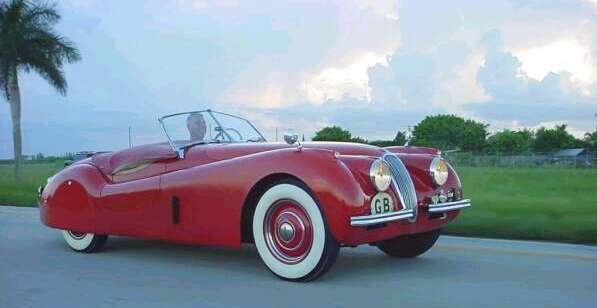 The pleasure of driving a classic XK120!
Russell Glace (South Florida Jaguar Club)
The pleasure of driving a classic XK120!
Russell Glace (South Florida Jaguar Club)
Below: XK120 at the Glen, by RogerSeitz (South Florida Jaguar Club)
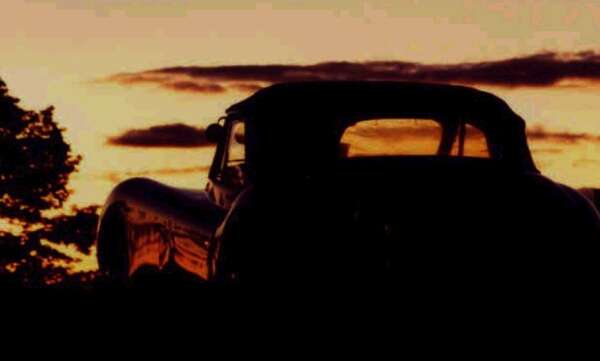
|
|

